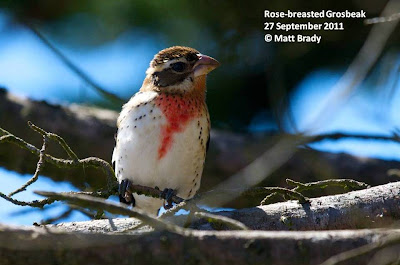 It’s Bird-A-Thon season at PRBO – our biggest annual fundraiser. On the Farallon Islands, we do things a little differently (not surprising)! Instead of counting just species of birds on a single day, we count all of the animals we encounter including birds, fish, marine mammals, insects, and any other wildlife we find over an entire week. We even assign points for rare and interesting wildlife events such as shark attacks and birds never before seen on the Farallones. This highly anticipated annual event is fondly referred to as the Farallonathon!
It’s Bird-A-Thon season at PRBO – our biggest annual fundraiser. On the Farallon Islands, we do things a little differently (not surprising)! Instead of counting just species of birds on a single day, we count all of the animals we encounter including birds, fish, marine mammals, insects, and any other wildlife we find over an entire week. We even assign points for rare and interesting wildlife events such as shark attacks and birds never before seen on the Farallones. This highly anticipated annual event is fondly referred to as the Farallonathon!Initiated in 1992, the Farallonathon was created to recognize the truly unique elements of the Farallones, while at the same time participating in PRBO’s Annual Bird-A-Thon. The Farallonathon consists of a one week bio-blitz where we identify as many species of wildlife as possible.
Money raised from this event goes directly to supporting Farallon research allowing us to purchase biological equipment, food and supplies for island personnel, and pay PRBO staff to analyze and publish the data we collect. The information gathered from our research helps us and others protect the wildlife that use these unique islands and the marine environment that surrounds them.
Please consider supporting our research by pledging either a per-point amount or a flat donation for the event. Today was our first day, so come back tomorrow to see how we fared.
What’s a typical ‘score’ for a Farallonathon? During the last 19 years, scores have ranged from a low of 129 points to a high of 240 (a good year for shark attacks)! The very first Farallonathon began auspiciously with a mega-rare Asian vagrant, the Northern Wheatear, but ended with only a modest 152 points due to very few shark attacks.
To support our research, you can donate a flat amount or you can make your pledge based on the Farallonathon point system. To donate a flat amount online, simply go to the Farallonathon team webpage: www.firstgiving.com/farallonathon and click on the “DONATE” button. If you prefer to make a donation based on our point system or do not want to use the online method, please email Jim Tietz (jtietz@prbo.org), Pete Warzybok (pwarzybok@prbo.org), or Russ Bradley (rbradley@prbo.org). All Farallonathon supporters will receive a detailed summary of our experience at the end of the event. You can follow our progress right here on this blog as we post our daily highlights, photos, and totals. Your participation allows us to continue studying this unique and vital ecosystem on the California Coast.
I hope you will join us!
Thank you,
Jim Tietz
PRBO Farallon Biologist
Jim Tietz
PRBO Farallon Biologist

POINT VALUES PER SPECIES SIGHTED
1 POINT: pinnipeds, bats, breeding birds, butterflies, cetaceans, dragonflies, fish, migrant birds, salamanders, shark sighting, turtles
5 POINTS: shark attacks, CA Bird Records Committee birds
10 POINTS: any new island record
**For most of the above, only a new species recorded during the week gets awarded a point. The exceptions are shark sightings, shark attacks, and CBRC birds in which each individual sighting is awarded points. For example, three shark attacks in one day gets 15 points, and two Connecticut Warblers receive 10 points.















































